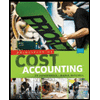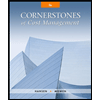
Concept explainers
a.
Income statement:
The income statement is a financial statement that shows the net income earned or net loss suffered by a company through reporting all the revenues earned, and expenses incurred by the company over a specific period of time. An income statement is also known as an operation statement, an earning statement, a revenue statement, or a
Material Inventory:
Material inventory comprises of the direct material costs, and indirect material costs that have not entered into the process of manufacturing.
Work in process Inventory:
Work in process inventory comprises of the direct material costs, direct labor
Finished goods Inventory:
Finished goods inventory comprises of the finished products that are completed manufacturing, but have not been sold.
To prepare: The March income statement for the Company DVM.
b.
The materials inventory, work in process inventory, and finished goods inventory balances at the end of the first month of operations.
Want to see the full answer?
Check out a sample textbook solution
Chapter 1 Solutions
Bundle: Managerial Accounting, 14th + Cengagenowv2, 1 Term Printed Access Card
- Please provide correct solution and accounting questionarrow_forwardThane Company is interested in establishing the relationship between electricity costs and machine hours. Data have been collected and a regression analysis prepared using Excel. The monthly data and the regression output follow: Month Machine Hours Electricity Costs January 2,000 $ 18,950 February 2,400 22,100 March 1,400 14,050 April 2,600 24,100 May 3,300 28,800 June 2,800 23,100 July 3,600 25,300 August 3,000 23,300 September 1,500 16,600 October 3,200 27,100 November 4,200 32,100 December 3,700 28,300 Summary Output Regression Statistics Multiple R 0.960 R Square 0.921 Adjusted R2 0.913 Standard Error 1,545.17 Observations 12.00 Coefficients Standard Error t Stat P-value Lower 95% Upper 95% Intercept 7,465.99 1,566.61 4.77 0.00 3,975.37 10,956.62 Machine Hours 5.76 0.53 10.78 0.00 4.57 6.95 Based on the results of the regression analysis, the estimate of electricity costs in a month with 1,700 machine hours…arrow_forwardThe direct materials price variance is?arrow_forward
- Please explain the solution to this general accounting problem with accurate explanations.arrow_forwardgiven correct option the general accounting questionarrow_forwardIf Bruce Industries had a net income of $580,000 in 2020 and it experienced a 15.4% increase in net income for 2021, what is its net income for 2021? provide answerarrow_forward
- help me with thisarrow_forwardA company can sell all the units it can produce of either Product M or Product N but not both. Product M has a unit contribution margin of $32 and takes six machine hours to make, while Product N has a unit contribution margin of $45 and takes nine machine hours to make. If there are 10,800 machine hours available to manufacture a product, income will be_. A. $3,600 more if Product M is made B. $3,600 less if Product N is made C. $2,000 less if Product M is made D. the same if either product is made.arrow_forwardHii teacher please provide for General accounting question answer do fastarrow_forward
 Managerial AccountingAccountingISBN:9781337912020Author:Carl Warren, Ph.d. Cma William B. TaylerPublisher:South-Western College Pub
Managerial AccountingAccountingISBN:9781337912020Author:Carl Warren, Ph.d. Cma William B. TaylerPublisher:South-Western College Pub Principles of Cost AccountingAccountingISBN:9781305087408Author:Edward J. Vanderbeck, Maria R. MitchellPublisher:Cengage Learning
Principles of Cost AccountingAccountingISBN:9781305087408Author:Edward J. Vanderbeck, Maria R. MitchellPublisher:Cengage Learning Cornerstones of Cost Management (Cornerstones Ser...AccountingISBN:9781305970663Author:Don R. Hansen, Maryanne M. MowenPublisher:Cengage Learning
Cornerstones of Cost Management (Cornerstones Ser...AccountingISBN:9781305970663Author:Don R. Hansen, Maryanne M. MowenPublisher:Cengage Learning Managerial Accounting: The Cornerstone of Busines...AccountingISBN:9781337115773Author:Maryanne M. Mowen, Don R. Hansen, Dan L. HeitgerPublisher:Cengage Learning
Managerial Accounting: The Cornerstone of Busines...AccountingISBN:9781337115773Author:Maryanne M. Mowen, Don R. Hansen, Dan L. HeitgerPublisher:Cengage Learning Financial And Managerial AccountingAccountingISBN:9781337902663Author:WARREN, Carl S.Publisher:Cengage Learning,
Financial And Managerial AccountingAccountingISBN:9781337902663Author:WARREN, Carl S.Publisher:Cengage Learning,





